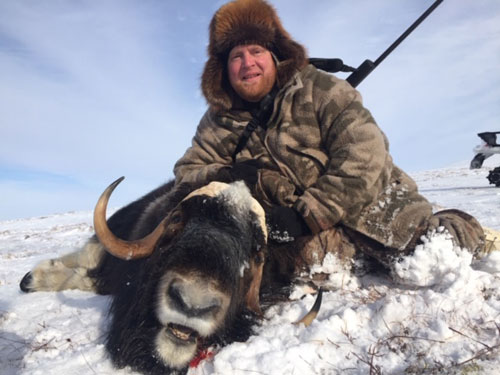
Aaron with his muskox 2018. © Sam Hancock
By Aaron Webber
The three muskox bulls were getting anxious and it appeared that they were about to run again. I had chased this particular bull several times from a larger herd, but after several failed attempts to get a clear shot, it had finally broken off from the herd with two other, smaller bulls. I jumped off my snowmachine and got ready with my 7 mm Mag. The largest bull had moved away from the other two and presented a broadside shot. I instinctively stood, aimed, and fired at the bull. The bull took off running. I reloaded and followed up with a second shot which knocked the bull to the ground. I had finally bagged my bull! I started shaking severely. Whether it was delayed buck fever, or the fact that it was freezing cold, or perhaps a combination of both, I don’t know. I calmed myself enough to climb back on my snowmachine and drove over to the downed bull.
The rest of the group arrived just before I did. My dad met me at my machine and gave me a big hug. The others whooped and hollered and gave me high fives as we all admired the bull. We snapped some pictures and took some time to rest and take it all in. This was the third and last muskox of the trip, and the weather was showing signs of a storm, so we decided to strap it onto my sled and tow it back to camp where we could start a fire in the tent and be able to butcher the animal with warmth a few feet away.
This story actually began over a year prior to the day I shot my bull, which was in early March 2018. In January 2017, I was unsuccessful in purchasing a muskox tag online as they all sold out within a few minutes. When I found out I did not get one I decided I would just buy a leftover taga at the Alaska Fish and Game counter, but that would not happen for two more days and I found out that there were already people standing in line at the Fish and Game office. I made a quick decision and gathered cold weather sleeping gear and drove to the Alaska Fish and Game office. I ended sleeping over night with 16 other people to be in line when the doors opened two days later to purchase an over-the-counter, first come, first served tag. The bull tags were all gone by the time my number came up, so I got a cow tag. I was thrilled! My friend Sam Hancock was lucky and bought a cow tag online so he and I made plans for a muskox hunt.
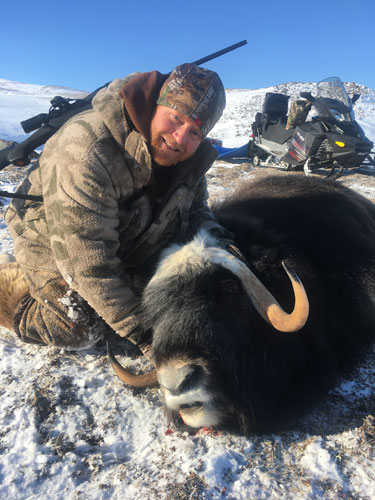
Aaron with his muskox 2017. © Sam Hancock
The season ran from Feb 1 – March 25, however, weather was the determining factor for hunting. Bethel is approximately 90 miles from Nelson Island, and if weather did not cooperate, there are many hazards that can be very serious. To get to the island, it is necessary to travel across Baird Inlet, a 30 mile stretch of water that may not be frozen in all places. It is difficult to see anything if there is wind-blown snow or fog. Then, when you get to the island and travel over it, fog may come up that will disguise the topography such that if you are not careful, you may just drive your snowmachine off a cliff. A good GPS is a must for a trip like this, especially since neither Sam nor I had ever traveled to Nelson Island.
Fortunately, that year the weather presented a window of opportunity with moderate temperatures and little wind, so Sam and I made the trip over to the island for our hunt. Weather was great going over, and the scenery was spectacular! We lost count after spotting 20 red foxes, and when we reached the island, we flushed hundreds of ptarmigan. Typically, I would have been trying to chase every fox and ptarmigan, but we were dedicated to muskox, so we left the smaller rifles behind. We put about 130 miles on our machines by the time we made it to camp, right on the edge of the Pacific Ocean. We were actually out on the frozen ocean on our snowmachines cruising along the coast to get to our camp. I never thought I would be able to say that I drove a snowmachine over the ocean, but we did! We set up camp and still had a few hours left of light, so we started glassing the surroundings. On the hill right above camp we spotted a herd of muskox. They were definitely accessible so we got our gear and started toward them. As we drove closer we were able to see them more clearly. It was a group of about 15 animals and they all appeared to be bulls, some of them very large bulls. As we were leaving that group to go back to camp we saw, high on the side of the mountain, an enormous lone bull with a very distinguished boss. The bull confidently moved across the hillside without a care in the world, stopping occasionally to search for something to eat below the crusted surface of the snow. He would glance in our direction but didn’t seem to view us as dangerous. Sam and I both admired the bull and wished we had bull tags. We decided to return to camp.
It sure is nice winter camping when you are in a comfortable camp. Sam brought along a 2-man Arctic Oven tent with a stove inside. We loaded the stove with a duraflame log and lit it, and within a few minutes we were warm and toasty and began boiling water on the stove. Dinner was a Mountain House freeze dried meal and we soon retired to bed, anxious for the next day. Our plan was to get up and wait for first light, then parallel the mountain cliffs, glassing as we went until we found a herd.
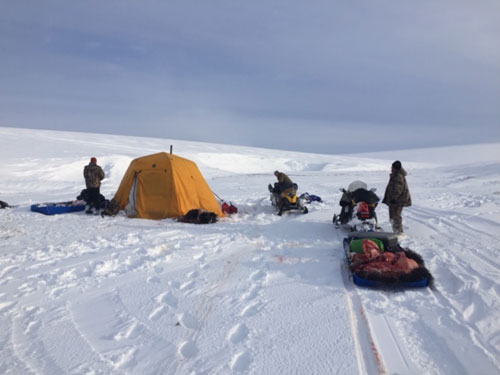
Muskox camp 2018. © Sam Hancock
Early the next day found us driving out on the ocean and stopping periodically to glass inland onto the cliff faces. The herd we had watched the night before was still relatively close to where we saw them previously. We located another large herd several miles away and raced toward the group to get a closer look. We approached the herd by driving up and around a large hill and then walking to be able to glass. We crawled up to the top of a knoll and began glassing from about 150 yards away. The herd was just sitting on a hill, all clumped together. There were bulls, cows, and calves and they didn’t know we were there. Neither of us had ever hunted muskox before, so we started trying to identify each animal to make sure we could find two cows. The Alaska Department of Fish and Game has a muskox identification quiz online that we both took and studied, but it is different identifying an animal on a computer screen and identifying one in a group of live animals. After probably 30 minutes of observation, we picked our animals and prepared for a shot. Sam fired first, and at the report of his rifle, the muskox fell to the ground. The others just got nervous for a minute but eventually settled back down, with the fallen animal in their midst. The animal I had selected presented a shot, and I dropped it with a well-placed shot to the lungs. Both dead animals fell in the middle of the group. As we approached the herd, we had to yell and scream to get the animals to run away. As I approached my animal, my heart began to sink when I noticed very faint black tips on the horns, an indicator of a bull. I had shot a bull instead of a cow. I felt sick as I came to a realization of my mistake.
We butchered our animals and prepared to make the trip back home the next morning. It was a very long trip home with my mind tortured with what had happened. I ended up turning myself in to the wildlife trooper when I got home and ultimately the state took possession of the muskox and it was delivered to a local shelter. I was happy the animal was put to good use, but I was not allowed to have anything at all from that muskox. Sam was gracious enough to let me try some meat from his animal, and it was delicious! The whole experience left a sour taste in my mouth and after licking my wounds and letting some time pass, I vowed to try again the next year.
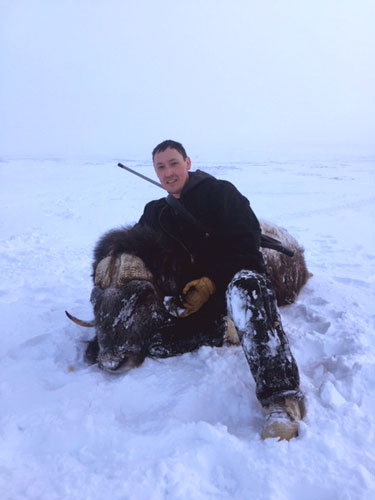
Sam Hancock with his bull 2018. © Aaron Webber
In 2018 Sam and I were both successful getting bull tags online, and another friend of ours, Jason, got a cow tag. My father was coming to visit from Idaho, and we planned the visit hoping the weather would allow us to go muskox hunting. It turns out the weather cooperated, so our group of four began the trip early in the morning darkness. With Sam leading the pack and me in the back, we headed west toward Nelson Island and made it in about five hours with frequent stops to regroup. Just as we approached the island, we encountered a large herd of muskox out on the ice. When they saw us, they bolted for land and Jason, who had the cow tag, circled up above them and ended up shooting a cow at about 50 yards. Sam was with him to make sure he shot a cow and not a bull. We were not going to make that mistake again! It was Jason’s first time hunting anything, and he was ecstatic to have just shot his first animal. I assured him that hunting is usually not this easy and it was beginners luck for things to work out that smoothly on his first hunting trip.
By the time we butchered Jason’s cow, a blizzard hit, and we were still 30 miles from where we hoped to camp. We began driving until the blizzard was just too much and safety became an issue. It was everything I could do to keep the running lights of the machine in front of me in sight. Sam wisely made the decision to stop right where we were and set up the tent before we got into trouble. The wind was blowing so hard that we could not get the tent to stand with four people. I decided to pull my snowmachine upwind of the tent so we could tie the tent to it so the tent wouldn’t blow away. I started my machine and tried circling around. I went about 15 yards and drove right into an unseen creek and toppled sideways into the slushy water. I was wet and scared. The wind was so fierce, and the group was so focused on the tent that they didn’t even know what had happened. I finally alerted the others by yelling at the top of my lungs and fortunately, with their help, I was able to get out of the situation, but my sled along with all my gear sank into the creek and we had to use a tow rope to pull it out. All of this was happening while one person was hanging on for dear life to the tent so it did not blow away!
We finally got the tent set up by anchoring it to the snowmachines and got a hot fire burning in the stove. Everyone was a little anxious as we huddled up next to the stove and cooked dinner. The wind was howling outside the tent, but inside I dried out enough to be comfortable again. After the long journey, butchering one muskox, and wrestling with the tent for an hour in the blizzard, sleep came easily.
When we woke up, we were pleasantly surprised to find that the wind had calmed, and we were optimistic for the day. The drifts had covered our gear overnight, and it took us a while to uncover our snowmachines and sleds. With good light, it was eerie to see where we decided to spend the night. There were steep hills all around us and we easily could have driven into a mess. It was a good thing Sam made the decision to stop. We finally got our gear ready and started heading for the coast, which was still more than 10 miles away according to the GPS.
We hadn’t driven more than a mile when we came upon a herd with a large bull. The herd took off and Sam positioned himself several hundred yards away in the direction they were running. Half of the herd went one direction away from Sam while the other group nervously formed a protective circle within gun range of Sam. Jason and dad drove to different angles away from Sam to try to deter the bull from running in their direction. I stayed where I was to watch if the bull ended up running back toward the other half of the herd. As I watched from a distance, I saw Sam get off his machine and then heard a shot. The herd ran away, leaving a furry mound behind. Sam had made a clean shot on a beautiful mature bull and now I was the only one left with an unfilled tag. We quickly processed the bull, and after stashing the meat, headed for the predetermined location to see if I could find my bull.
Over the next few hours, we looked over roughly 60 animals including multiple bulls, but none really stood out as a shooter. During this entire time, we didn’t see another hunter. By mid-afternoon, we found a herd that had a nice bull in it. With our experience from the previous night, and with weather conditions showing signs of another storm, I decided I better try to fill my tag and make it back to camp sooner than later. That brings us back to the beginning of this story.
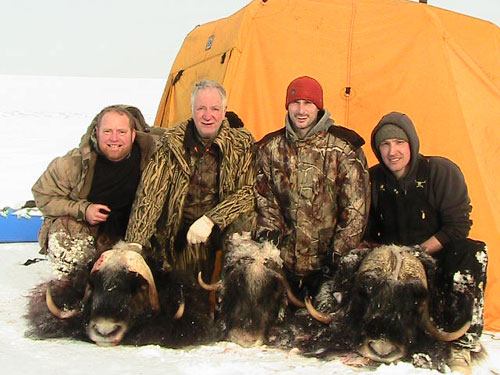
The successful hunting party, March 2018: Aaron, Frank, Jason, and Sam. © Aaron Webber
A herd of about ten animals had three bulls in it, one of which was bigger than the other two, and I ended up taking him. I finally had a bull that I could be proud of and was able to do it with the company of my father and two good friends. My dad has been a hobby taxidermist for many years and is planning on doing a shoulder mount of my bull. The meat is delicious and helps feed our family. It was an amazing hunt, one that I will remember for a long time to come. I hope to be able to chase a muskox again someday!
Aaron Webber works as a fish biologist in Bethel, Alaska. When he is not spending time with his wife and three small children, he is usually on some kind of adventure involving hunting, fishing, or trapping somewhere in the state.
Find more articles here.
